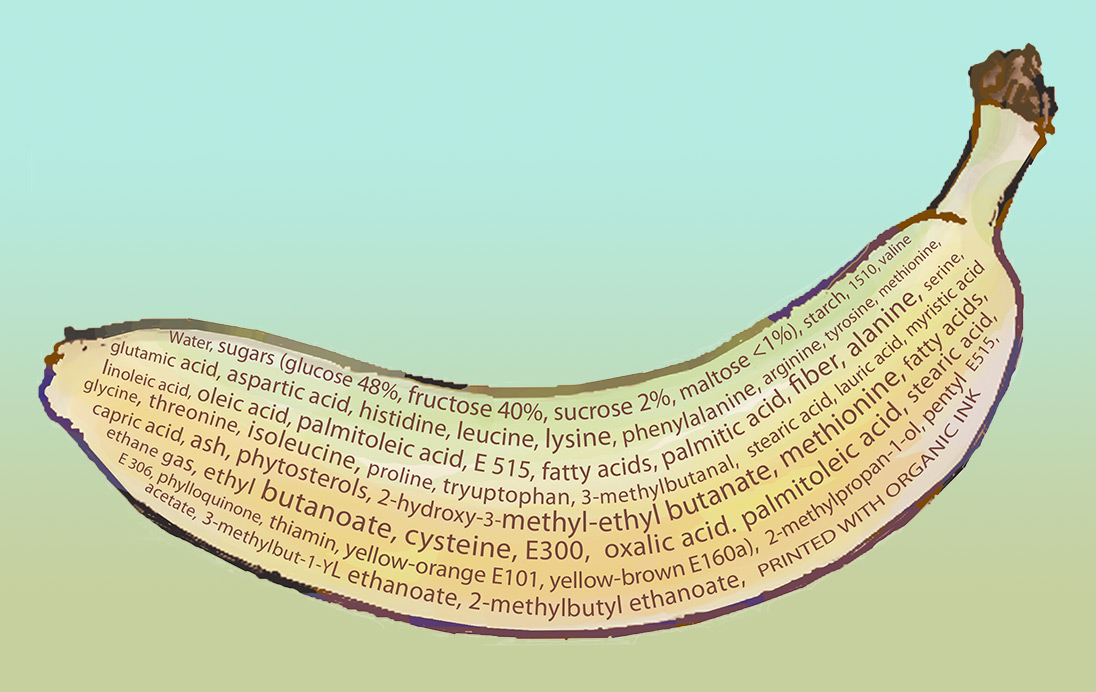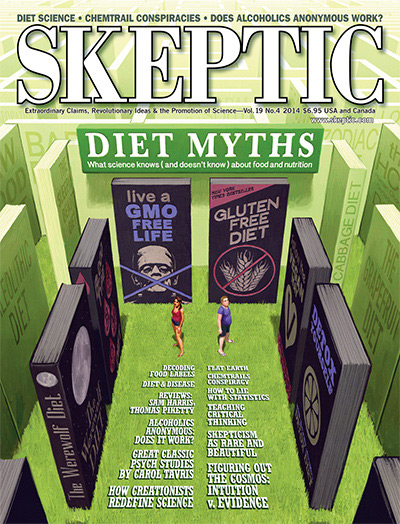In this week’s eSkeptic:
Skeptic magazine 20.1
Terrorism
The latest issue is now available digitally via the Skeptic Magazine App for iOS, Android, BlackBerry PlayBook, Kindle Fire HD, Mac, PC, and Windows 8 devices. You can also order the print issue from Shop Skeptic. Current print subscribers should receive this issue by the end of March.

Skepticality: On The Side
SKEPTICALITY EPISODE 249
Skepticality is almost a decade old. In light of the upcoming landmark, Derek and the show’s usual crew of contributors decided they needed to start bringing to listeners different content to supplement the standard format. Today, we present the first installment of Skepticality: On The Side in which you can listen in on Derek, Susan Gerbic, Tim Farley, and Bob Blaskiewicz as they discuss the history of Skepticality, and some of the hot topics they have been following in the realms of skeptical thought and pseudoscience.

About this week’s eSkeptic
Phenylalanine, butyric acid, methionine, sodium tripolyphosphate, 2-methylbutyl ethanoate, pentyl acetate, monosodium glutamate… What are all these long, hard-to-pronounce chemicals listed on food labels? Should we avoid them? In this week’s eSkeptic, Harriet Hall, M.D. decodes the preservatives, coloring, and taste-enhancers in food.
This article appeared in Skeptic magazine 19.4: Diet Myths. This issue is available digitally in the Skeptic magazine App, and is sold out in print format.
Decoding Food Labels
by Harriet Hall, M.D. (a.k.a. The SkepDoc)
It is only natural for food companies to present their products in the best light so people are more likely to buy them. If they can give the impression that their foods are healthy, low in calories, and low in added sugar, it’s to their advantage. But food labels can be confusing. What do all those long, unpronounceable words mean? Today, labels must show percentages of the recommended daily allowance (RDA) of nutrients and list all ingredients in order of weight. Usually the label informs, but sometimes it misleads.

Read more great articles like this one in Skeptic magazine 19.4: Diet Myths. This issue is available digitally in the Skeptic magazine App, and is sold out in print format.
Labels show the calories per serving, but be careful! What is a serving? How many servings are in the package? A can of fruit labeled 60 calories per serving contains 3½ servings or 210 calories. When my husband and I open a can of fruit, we’re likely to split it between the two of us, not measure out portions and save 1½ servings for a future occasion. A casserole dinner kit lists 240 calories per serving “as packaged” but 410 calories per serving “as prepared,” and there are 4.5 servings per package; handy if you are fixing dinner for 4.5 people. Labels can trick people into eating more calories than they think they’re getting.
Check the salt content, which is typically high in canned and prepared foods. Too much salt can be unhealthy. Roast beef contains 48 mg of salt per 100 gm; corned beef contains 950 mg per 100 gm. Canned salmon has 110mg; smoked salmon, as much as 1800 mg. Prepared foods may exhaust the entire RDA of sodium with a single serving.
Remember when cholesterol was demonized and all the product labels trumpeted “contains no cholesterol”? That label appeared on vegetable shortenings that were hydrogenated and full of trans fats that are much worse than cholesterol, so bad that they have now been banned by law in some places. The real irony is that cholesterol is a product of animal cells and is not found in any vegetable products. Labeling a vegetable oil or shortening as “contains no cholesterol” is as unnecessary as labeling salt as “contains no high-fructose corn syrup” or a cucumber as “contains no bacon.”
The Food Babe—the American blogger and food critic Vani Hari— rejects any foods containing ingredients she can’t pronounce. She is proud of her ignorance. I guess if water were labeled dihydrogen monoxide, she wouldn’t drink it. Wouldn’t it be better to try to learn what the big words mean and why the additives are there? Food manufacturers don’t throw in random chemicals just for the fun of it.
Preservatives
Our ancestors discovered early on that drying, smoking, and salting would preserve foods so they would keep longer. Additives make foods last longer and help prevent food poisoning. The average person consumes a pound of additives per year, but this includes 2000 different chemicals and the amount of each one is tiny. Arguably, making the food last longer outweighs any small theoretical possibility of harm from such tiny amounts. The poison is in the dose, and the food additives that are permitted by law have been tested for safety.
Radishes contain a substance that can cause goiters, oranges contain a toxin that could potentially cause birth defects, carrots contain the hallucinogen myristicin; there is practically no food that doesn’t contain some chemical that could harm people in large doses. “Healthier” hot dogs are advertised as containing no added nitrates and no preservatives, but they don’t advertise that one of the ingredients they use, celery juice, is rich in nitrates; there was no need to add preservatives because a preservative was already naturally present. The presence of toxins doesn’t mean we should stop eating food. The nutritional benefits of food far outweigh the negligible harm from tiny amounts of chemicals. Coffee contains 10 mg of known carcinogens per cup but is also the leading source of antioxidants in the American diet.
Washing apples to remove pesticide residue removes the natural surface wax that protects the fruit from drying up. When sellers wax their apples, they add morpholine to make the wax easier to apply; it converts to nitrosomorpholine in the body, which might cause cancer in animals in huge amounts. The amount from an apple is far safer than the nitrate naturally present in cabbage, which converts to carcinogenic nitrosamine in the body.
A box of mashed potatoes contains sodium bisulphite, sodium sulphite, citric acid, BHA, and BHT. These are anti-oxidants that prevent oxidation of fats, tie up free radicals, and preserve freshness. Rats get liver abnormalities from high doses of BHT, but they live about 25% longer! Mayonnaise contains EDTA, which ties up metal ions to keep food from turning brown. Calcium propionate is a preservative used in bread to keep it from going stale so you don’t have to buy it fresh every day. The holes in Swiss cheese are produced by natural propionic acid in the cheese, 20 times more than what is added to bread.
Sugar is a good preservative: bacteria can’t survive in high concentrations of sugar because of osmosis. That’s why you don’t need to keep honey in the refrigerator. Health food catsup uses corn syrup sugar instead of the table sugar used in regular catsup. It advertises “no preservatives” but catsup doesn’t need preservatives. It is 30% sugar, and bacteria can’t live in it.
Food Colors
Added food colors can be natural or artificial. Natural sounds better but isn’t always. The most widely used natural food color is caramel, used in cola drinks. In the production of caramel an animal carcinogen, 4-methylimidazole, is produced. Under Proposition 65 in California, all potential carcinogens must be listed on the label. To prevent scaring off consumers, cola manufacturers recently changed to a different technology.
Another natural color, cochineal red, is added to foods like cherry ice cream. It is made from crushed insects. If consumers were given a choice between natural insects and artificial colors in their ice cream, they might prefer the artificial option.
Artificial colors are controversial. The term “certified” only means that the manufacturing process has been checked to insure that it produces what it is supposed to. Synthetic food colors have been blamed for causing hyperactivity in children, probably unjustly. Red dye number 2 is banned in the U.S. but allowed in Canada. Red dye number 3 is used to color Maraschino cherries. It was found to cause thyroid tumors in rats, but only in male rats and in amounts corresponding to feeding a human 14,000 servings of fruit cocktail a day for 70 years. There is one legitimate reason for avoiding both synthetic and natural food colors: the foods they are added to are likely to be poor in nutritional value.
Taste Enhancers
Additives are used to improve flavor and texture. Some kinds of ice cream contain no cream, only milk solids and sugars. To provide the desired creamy texture they use natural vegetable additives such as carob bean gum, guar gum, and carrageenan. The hard-to-pronounce carboxymethylcellulose is added to prevent the formation of ice crystals. Artificial smoke flavor is produced by passing smoke through a water solution; the most toxic chemicals are not picked up by this process, so it should be safer than real smoke flavor.
Butterball Turkey doesn’t contain butter, it contains margarine made from palm oil and palm kernel oil, which have more saturated fat than butter. It contains sodium phosphate (sodium tripolyphosphate, STP or STPP) to retain moisture and improve texture. Some ignorant people have confused this harmless preservative with the kind of STP used in cars or with the phosphate used in incendiary bombs.
Butterball contains both “flavor” and “artificial flavor.” The first comes from natural sources, like milk or lactose components to imitate the flavor of butter. The second comes from synthetic sources. Imitation butter flavor contains a mix of butyric acid, glycol, organic acid, acetone, and ethyl butyrate; the combination of several chemicals is required to create the flavor.
Monosodium glutamate enhances flavor but may cause Chinese Restaurant Syndrome—symptoms include flushing, headache, numbness or burning in the mouth, a sense of facial swelling or pressure, and sweating. Some restaurants advertise they don’t use MSG, but they substitute seaweed, a natural source of MSG. Other foods like cheese, tomatoes, and eggs contain glutamate and form MSG in the presence of salt.
High fructose corn syrup isn’t much higher (55% vs. 50% in table sugar) and contains less fructose than some fruits. Labels may disguise sugar with other names: dextrose, maltose, invert sugar, honey, fruit juice concentrate, corn sweetener, malt syrup, molasses, etc. I’ve seen a single label list as many as 5 different kinds of sugar.
Should We Try to Avoid Chemicals?
We can’t avoid chemicals because everything is made of chemicals. Here, for example, is a list of the chemical ingredients of the ordinary all-natural banana:
Water, sugars (glucose 48%, fructose 40%, sucrose 2%, maltose <1%), starch, fiber, glutamic acid, aspartic acid, histidine, leucine, lysine, phenylalanine, arginine, valine, alanine, serine, glycine, threonine, isoleucine, proline, tryuptophan, cysteine, tyrosine, methionine, fatty acids, palmitic acid, linoleic acid, oleic acid, palmitoleic acid, stearic acid, lauric acid, myristic acid, capric acid, ash, phytosterols, E515, oxalic acid, E300, E306, phylloquinone, thiamin, colors (yelloworange E101, yellow-brown E160a), 3- methylbut-1-YL ethanoate, 2-methylbutyl ethanoate, 2-methylpropan-1-ol, 3- methylbutyl-1-ol, 2-hydroxy-3-methylethyl butanate, 3-methylbutanal, ethyl exanoate, ethyl butanoate, pentyl acetate, 1510, and ethane gas.
That list would be enough to scare the Food Babe half to death!
Eat fresh foods whenever you can, but when it is more convenient to eat processed foods, don’t be too concerned about the possible dangers.
For more information about nutrition, I highly recommend the free online course “Food for Thought” featuring skeptic “Dr. Joe” Schwarcz and his colleagues from McGill University. I learned a lot from it and borrowed from it in preparing this column. It will be offered again starting in October 2014. ![]()












